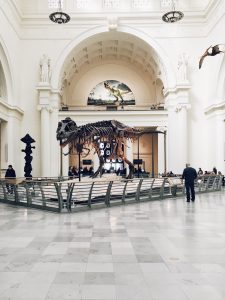
Modern Technology
Technology can be a wonderful thing by bringing ease and comfort to our lives. Medical advances have helped people live longer, communication devices allow people the ability to talk with each other on opposite sides of the planet, and people find entertainment from images that do not really exist. Technology has influenced the education field also. Educators can take their students on virtual field trips, primary source documents are at their fingertips, and even lectures at different learning levels can be watched in the classroom or even while riding the bus to or from school. Thanks to smart phone technology and the internet people literally hold the complete sum of human knowledge in their hands. For museums, this can be a blessing and a curse.

Museums Benefit
Technology has been a big benefit to museums in the gallery and behind the scenes. The museum’s research mission receives a big boost from modern advancements in technology. High tech scanners that use x-rays and magnetic spectrum imaging have allowed researchers to study objects in new ways. As a result, researchers are able to gather more information that was previously impossible to uncover by using the old imaging methods. This helps to give historians a clearer picture of the history they are attempting to convey to the public. Knowing the chemical makeup of a piece of pottery allows archaeologist to be able to trace its origins and learn how far the piece traveled when it was in use. This information will aid researchers in recreating trade routes or migration patterns with less speculation and guess work. In addition, the museum can preserve and restore pieces better than ever before by making use of modern technology. New developments in areas like cooling and handling of materials will allow curators to preserve objects longer and keep them in better condition. Being able to analyze materials allows a more authentic restoration of deteriorating items allowing the objects to survive longer. The gallery can also make use of technology to give a better experience to visitors. The use of tablets will allow guests to interact with the exhibits in ways that were impossible 20 years ago. Enhanced reality allows peaks back in time for a clearer understanding of artifacts. Enhancements like these bring the public in the door; however, there are problems that technology presents.
Museum Hindrances
The biggest drawback to incorporating technology in an existing museum is the cost. Improving the museum and updating the infrastructure takes large amounts of money. This can affect the museum in two ways. The first being that there is not enough money to acquire new pieces for display. In this situation, the director must make a decision between the ability to grow and enhance the collection or improving the experience for the guests. The second is that the museum would be required to increase fundraising initiatives or find new sources of capital. Technology will not work without proper financial support, and this could be a bigger problem for museums that are smaller and local. These smaller museums do not have the resources for more advanced technologies like building a VR experience into their gallery. Often museums will turn to corporate partners to be able to afford the improvements. This approach does bring in the money, but walking through the Walmart Hall of Early Man does not bring an academic feel to the place.

Finally, museums also have to compete with home technology. People are able to access photographs and in some cases virtual reality right from their couches. Museums must be able to offer an experience that goes beyond what people can view at home. Museums must continue to promote their collections and make them enticing enough to get people to log off and walk in.

Hey Scott, great post about the pros and cons of utilizing technology in museums. I think you touched on some really great points, especially how smaller museums will suffer because they cannot afford to incorporate cutting edge technologies larger museums can. Based on our class discussions, it seems like smaller museums have many disadvantages to overcome.
Another disadvantage I would add is the lack of engagement, especially with younger kids. I used to teach an after-school STEM club for middle school girls where we would take them on field trips to different museums. Looking back, their phones were such a hindrance to the learning experience! Even interactive tools like QR codes can be more of a novelty than anything for a disengaged audience. As an educator, I’m curious what your take is on technology in the classroom?
Scott,
What a thought provoking post! While I agree that technology can be a ‘double edged sword’ for museums and educators, I err on the side of technology. I think it is important for museums to try new technology in an attempt to garner interest among students.
While not every piece of technology will work with every exhibit, I believe that a curator who uses technology towards the end of engagement with the observer will prove to be the most successful use of technology. Along the way museums will try some tech things and miss the mark, but I feel that is the only true way to challenge the status quo.
With regards to the fundraising aspect, I think it is important to challenge local corporate partners to aspire to inspire through their support of great exhibits. While I don’t believe San Antonio will see major support from corporations outside South Texas, I think it is vital to challenge our local corporate partners to help us better tell our story. I would use the Witte as a great example of a successful museum that walks that line well.